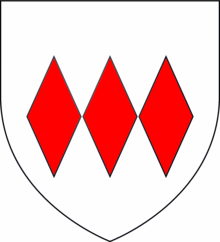William Montagu, 2nd Baron Montagu
| William Montagu, 2nd Baron Montagu | |
|---|---|

Arms of Montagu: Argent, three fusils conjoined in fess gules
|
|
| Spouse(s) | Elizabeth de Montfort |
|
Issue
John Montagu
William Montagu, 1st Earl of Salisbury Simon Montagu Edward Montagu, 1st Baron Montagu Alice Montagu Katherine Montagu Mary Montagu Elizabeth Montagu Hawise Montagu Maud Montagu Isabel Montagu |
|
| Father | Simon Montagu |
| Mother | Hawise St Amand, or Isabel (surname unknown) |
| Born | c.1285 |
| Died | 18 October 1319 Gascony |
William Montagu, 2nd Baron Montagu (c. 1285 – 18 October 1319) (alias de Montagu, de Montacute, Latinized to de Monte Acuto ("from the sharp mountain")), was an English peer, and an eminent soldier and courtier during the reigns of Edward I and Edward II. He played a significant role in the wars in Scotland and Wales, and was appointed steward of the household to Edward II. Perhaps as a result of the influence of his enemy, Thomas, 2nd Earl of Lancaster, Edward II sent him to Gascony as Seneschal in 1318. He died there in October of the following year.
William Montagu was born in about 1285, the son and heir of Simon de Montagu, 1st Baron Montagu (d. 26 September 1316), by either his first wife, Hawise de St Amand(died 1287), daughter of Amaury de St Amand, or his second wife, Isabel, whose parentage is unknown. The Montagu family was of Norman origin, later prominent in the West Country of England. They held extensive lands in Somerset, Dorset and Devon. From his father's inquisition post mortem, he is known to have had two brothers, John Montagu and Simon Montagu.
Montagu spent a great part of his life serving in the wars in Scotland, Wales and on the continent. He distinguished himself in the First War of Scottish Independence, having been summoned for feudal military service in 1301 and placed in charge of shipping for the war in March 1303. In 1304 he was with King Edward I at the Siege of Stirling Castle. In the same year he and his uncle, Amaury de St Amand, were imprisoned in the Tower of London for an alleged offence for which he was soon acquitted. On 22 May 1306 he and others were knighted by King Edward I (1272–1307), together with the king's son the Prince of Wales and future King Edward II (1307–1327). In February 1307 he and his father served together in Scotland, and in 1309 he took part in the first tournament at Dunstable in which he bore the arms Argent, three fusils conjoined in fess gules, as recorded in the Dunstable Roll. In 1311 he was appointed to survey the defences of Hastings Castle and other castles, and on 29 September 1311 was placed in charge of Berkhamstead Castle. In 1314 he was appointed Keeper of Berwick Castle.
...
Wikipedia
